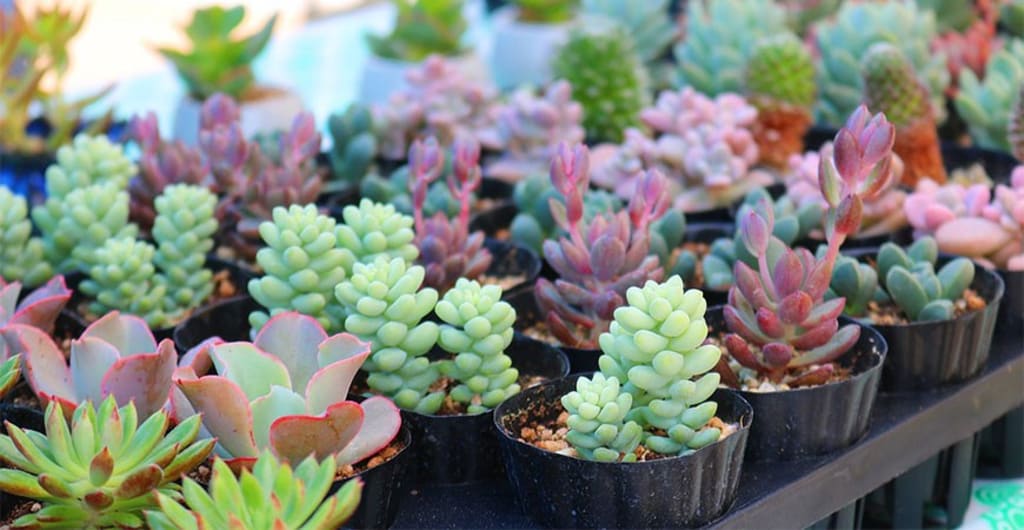
They’re now the order of the day for anyone with the slightest interest in houseplants. I bet you have one of them sitting somewhere at home or in the office.
Just take a look around.
Even for the few who cared to cultivate these plants, not much significance was given to see to it that they develop into the beautiful masterpieces of today. They were left to soak up unholy amounts of water and rot — after which they’d be discarded.
But not anymore. In today’s web-centric world, the trends are out there for anyone who cares to note. Plus, succulents are less maintenance heavy compared to other house plants.
Away from the (numerous) Instagram glitz, the numbers are speaking louder. A peek at Google Trends shows a continued rise in interest in the past 10+ years.
There is a reason. In fact, several of them. But before that…
Were Succulents Popular Before?
Way back then — as far as the 18th century — succulents had a special place in many people’s lives; especially the royals.
In Europe, explorers had just discovered succulents in the distant world (parts of East and South Africa) and were bringing them back. And the interest picked up almost immediately.
Soon enough, botanical expeditions were being held across the continent between individuals and societies showcasing their succulent’s collection.
Fast forward to the 20th century (in the 70s) when the buzz caught on again but fizzled out until recently — and Millennials are among those bitten by the succulents’ bug.
Do Millennials Love Succulents?
Millennials have a general inclination to house plants, for a couple of reasons.
For one, more and more are preferring not to buy houses. Instead, they live in rented apartments. That means no compounds to launch a full-fledged garden for the interested. And what other better way of quenching their gardening thirst than procuring a few houseplants?
And this is where succulents tie in best — because they come with the convenience of occupying teeny spaces.
Another reason for the millennials-houseplants dalliance is the fact many reside in urban areas like New York City or San Francisco and probably work late hours. (They’re always out there hustling nowadays).
As such, they have minimal (if any) interaction with nature. So nurturing a few sprouts presents the perfect opportunity for reconnecting with nature.
All in all, though, the succulents romance cuts across the generations. Time to look at why.
Succulent plants can grow anywhere
Succulents are hardy plants by nature. They can withstand most of the harshest environmental conditions like small amounts of water and extreme temperatures; the two factors that will make most houseplants to give it up.
As long as you have the basics nailed down (potting mix, sunlight duration, and watering frequency), you can nurture your succulents from any corner of the world — and still have a beautiful plant.
Succulents are convenient for growth
The growth of most succulents is well in line with the needs of someone in a limited space, e.g. rented apartments or 100 sq ft closets in New York City.
Most of them don’t grow quickly, filling up lots of space. And this is not a matter of only space; it means you’re free from — the additional — baggage of having to train or move them. Talk about the perfect combo!
Succulents require very little maintenance
Ask yourself this. What’s the typical maintenance regimen for the average plant?
There is watering — almost daily, frequent pruning, checking for pests and diseases — and doing the necessary and moving them around as they outgrow their spaces. And, not forgetting, training those that need to.
Succulents don’t need all these requirements for growth. Even for the caring requirements that apply to succulents, the intensity of application is much lower for even better growth.
Take, for example, watering. You’ll need very few watering sessions for succulents if you want a vibrant plant. And pruning? Not much, unless dry leaves happen in winter.
Very easy to propagate
Increasing your collection of succulents isn’t half as hard as doing so for many varieties of houseplants. And you can also be a savior to your friends who might need one or two plants to start with.
Unless you want a completely new type, multiplying your succulent plants is super simple via their parts. These can be stems, leaves, and offsets.
You can dig up the basics of going this route and be a total boss at it. Ooh, and when you’re done, ask around for new types from your friends to further expand your succulent empire.
Very beautiful and aesthetic looking plants
Succulents appeal on multiple fronts making it a rare jewel. With these plants, you get natural decorations in different shapes, sizes, and colors — all unique to each of the numerous types.
What’s even more interesting is that you can vary the colors of a good number of succulents by controlling elements such as water and sunlight.
For instance, an extended period of little water and lots of sunshine can lead to your succulents becoming red, purple or orange. Of course, should be careful not to harm the plant. A better approach at having a pleasing mix of shapes, sizes, and colors is stocking different types of succulents.
Succulents have many use cases besides looking pretty
Succulents aren’t just for your house.
Depending on the types you’re nurturing, you can find a gazillion of ways to utilize them. Owing to their hardy nature, they can be put in many designs and arrangements and still be able to appear dapper. Away from home, you can find them as decorations in public places like coffee shops.
Besides that, they can also be used as wedding bouquets. But the most crucial alternative use is one that leans on the medicinal side. A select few can be processed or used raw to treat certain illnesses. Aloe Vera leads in this category with proven abilities to treat several skin conditions, acne scars, and indigestion.
About the Creator
Wave
move to and fro with a swaying motion while remaining fixed to one point. Check me out on Medium too!






Comments
There are no comments for this story
Be the first to respond and start the conversation.